Abstract
The current educational and social context has the characteristics of a hostile environment being a junction between violence - aggression - bullying - cyberbullying. The need to analyze the phenomena of bullying and cyberbullying in the school environment stems precisely from the fact that today's intimidation behaviors are recognized as adolescent adaptation problems. Therefore, the issue of aggressive acts of bullying and cyberbullying in the Romanian education system, especially the pre-university education, is appropriate to the current educational and social context undergoing reforming and reconfiguration. The perception of the future society is realized in the school environment, through the formation of new generations, their personality and through them the socio-economic-cultural environment in which future generations will live. Thus, this paper is based on existing research in the field, aiming to improve the educational climate. Bullying and cyberbullying is a major issue, of acute relevance both in schools in Romania and around the world. The complex and multidimensional phenomenology of bullying and cyberbullying aims at conceptual delimitation of violent, aggressive behavior present in the educational environment by highlighting the differences between these notions specified by the literature. This paper aims to measure the incidence of bullying and cyberbullying among middle school pupils and also to develop a profile of pupils in Cluj County regarding bullying and cyberbullying. The study was conducted with 150 middle school students from Cluj County, Romania.
Keywords: Bullyingcyberbullyingschool aggressionschool violencemiddle school
Introduction
The researchers' attention was also drawn to the indirect forms of psychological aggression and relativity to another form of intimidation called cyberbullying in the early 90s. Since 2000, research into the concept of cyberbullying has evolved rapidly, although the literature is quite inconsistent with regard to this phenomenon. Olweus ( 1999) defines violent behaviour as aggressive behaviour in which an individual or perpetrator uses his body or an object (including a weapon) to strike (relatively seriously) or cause discomfort to another individual. Essentially adolescents who have such a hostile behaviour have a low empathy towards the victim.
In adolescent groups, violence and bullying is normal, but violent behaviour is not accepted, although it exists, bullying / cyberbullying is a tolerable phenomenon, as part of everyday life. We can make a distinction between the concept of aggression, defined as intentional behaviour that sometimes causes injuries or discomfort to others and the notion of violence as an abuse of physical, psychological or institutional power, child maltreatment, and intimidation, expressed through marginalization, victimization or exclusion.
The history of a construction project on school violence, security and safety at school, at European level, emerged in 1997 at the Utrecht Conference in the Netherlands where it was found that in many European countries statistics and concrete data were missing for this phenomenon. The debates on the definition highlight a difference between recent research and policies concerned with school violence and some older, stronger practices in some countries. These practices and research did not concern violence as a whole and were not using the term either.
In the school environment, adolescents encounter various forms of violence, from brutal variations involving physical blows, vulgar language, humiliation within the group they belong, to a newer version of online, subtle, sophisticated violence, and somewhat harmful - cyberbullying. Thus, alongside the traditional forms of violence in the school environment, surges, injuries, sexual violence, new forms of manifestation of this behaviour have been identified with the development of the online environment, namely the behaviour of cyberbullying in adolescents. Given the precocious behaviour of the current generation of adolescents and the high social abilities, situated above the previous generations, which have been acquired through the use of existing computer resources, sometimes even used before the child can speak, it is necessary to identify early forms of traditional violence in the school environment and new forms of cyberbullying, by developing effective prevention and intervention strategies.
According to Sullivan ( 2011), "Bullying is a conscious, intentional and repeated act of aggression and / or manipulation and / or exclusion by one or more people against another person or persons" (p. 10). If violence is described as a physical and mental illness, bullying is a form of intentional physical and mental violence, in the long run, aimed at causing damage. Although violence crosses the boundary of legality, the phenomenon of bullying / cyberbullying falls within the limits of the law, even if the latter phenomenon is more detrimental than any other source of stress.
Conceptually, a number of researchers ( Cairns & Cairns, 1991; Germain & Bloom, 1999) have studied several factors that invariably influence behavioral patterns. This happens because people belong to different social and environmental contexts. Such factors include individual characteristics, cultural conditions, social interactions ( Cairns & Cairns, 1991).
To explain the forms of aggression in the school environment, Mureşan and Porkolab ( 2017) have introduced two notions -
The absence of a "school of parents" often leads to a lack of skills, a precarious preparation of the adult for assuming the role of parent in accordance with th
Problem Statement
The importance of the issue of aggressive acts of bullying and cyberbullying lies on the one hand that the defining elements of the two phenomena have been insufficiently analysed and, on the other hand, in the present day, bullying and cyberbullying are, an area of exciting, scientifically and scientifically applied theoretical and applicative research, although increasingly exploited. Also, the lack of systematic approaches to the causality of the two phenomena has allowed the creation of myths such as, for example, that the school population can be a factor favouring violence.
Research Questions
The research question of the current study focused on finding answers regarding the prevalence of the acts of bullying and cyberbullying in the gymnasium schools. One of the main interests was revealing a profile of the students in the schools in Cluj county, Romania.
Purpose of the Study
The current study tried to establish the level of bullying and cyberbullying among students of gymnasium. The objective of this research is to determine if acts are bullying and/or cyberbullying are prevalent as a victim or as inflictor. The purpose of present study is to inventory the acts of bullying and cyberbullying most present in the students school and home life.
Research Methods
Participants
The participants to this study were 150 gymnasium school children (N female=53, Nmale=97) enrolled in the seventh and eight grade (N seventh=70, N eigth=80) in schools in Cluj-Napoca, Romania with the age between 13 and 15 (M age=14). The participants to this study come both from rural and urban environments (N urban=115, N rural=35).
Design
A survey method was used to better understand the phenomenon of bullying and cyberbullying. Two questionnaires were designed one for bullying and one for cyberbullying consisting of 16 and respectively 18 questions. There were questions that had multiple choice, dichotomous questions and also open-ended questions. The students answered the questions on paper and their answers were analysed using statistical tools.
Bullying questionnaire results
The first question was referring to bullying situations that students encounter in their daily school lives. The results can be found in Figure
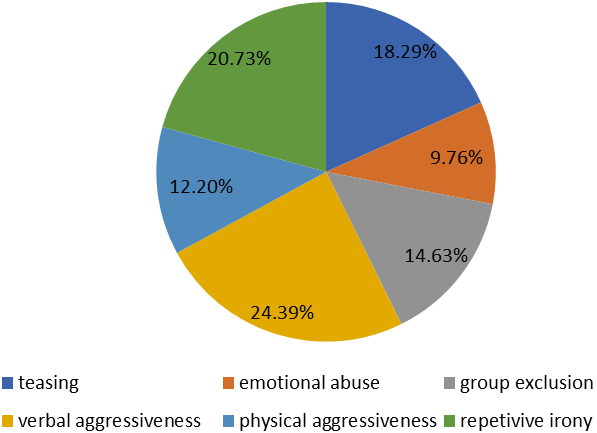
The results show that 24,39% of the students have encountered acts of verbal aggressiveness, 20,73% of the students have encountered cases of repetitive irony in their school, followed by 18,29% of the students report about physical aggressiveness.
The answers to question 8: “One of the following behaviours has been shown by a colleague in school…” revealed the following results depicted in Table
The results show that 84,2% of the males and 82.1% of the females have encountered pushing behaviours, 73.7% of the males and 67.9% of the females have met with hitting behaviours.
Question number 14 was design to identify the behaviour manifested by the participant to their colleagues. The results are present in Table
The results show that 75% of the males and 55.6% of the females have manifested pushing behaviours towards their colleagues in school, 43.8% of the males and 44.4% of the females have manifested hitting behaviours towards theirs peers.
Question 15 revealed answers concerning aggression situation witnessed in school by the students (Figure
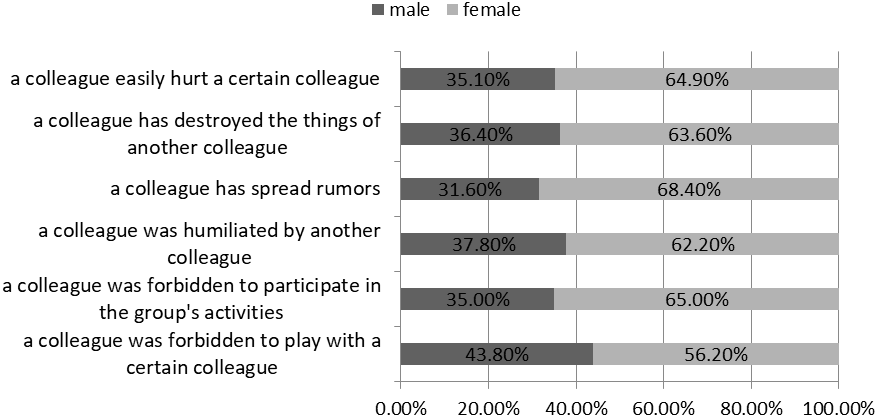
Cyberbullying questionnaire results
The second questionnaire was design like the first questionnaire presented above and also included questions about the internet behaviour of students on daily basis.
The first questions were related to the access of the internet and the purpose of the internet in students’ life (table
The answers show that 75.47% of the respondents that access the internet daily are from the urban area and 24.53% are from the rural area.
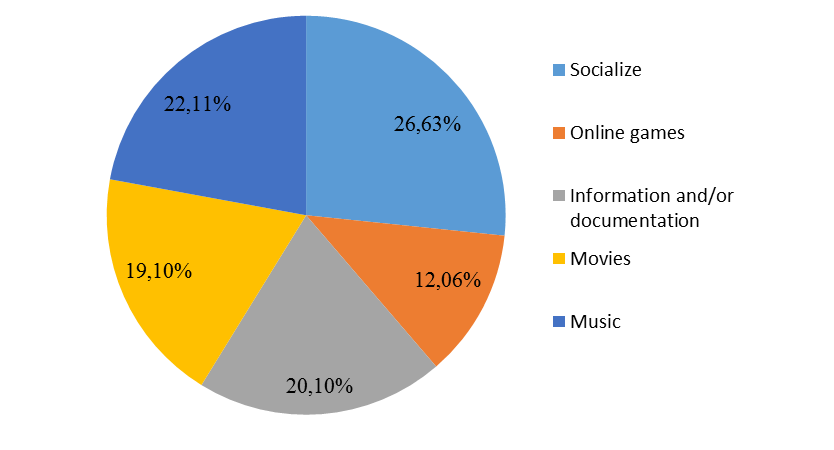
Students access the internet for a variety of reasons: 26,63% access the internet for socializing, while 22,11% access the internet for online gaming.
The fourth question was referring to cyberbullying situations that students encounter in their daily access to the internet. The results can be found in Figure
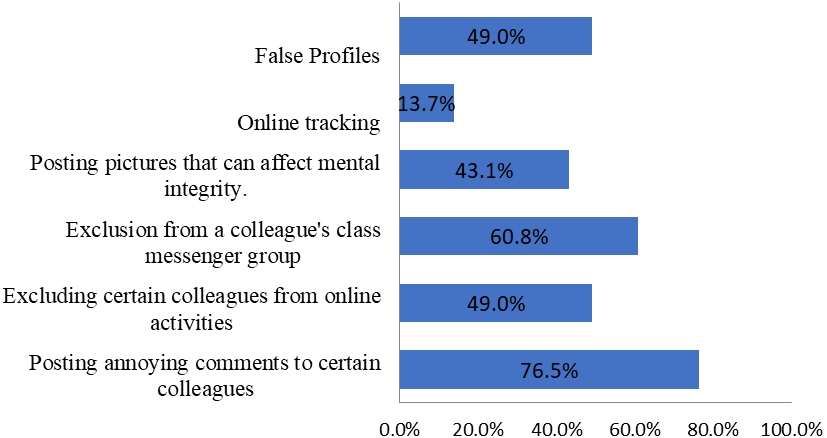
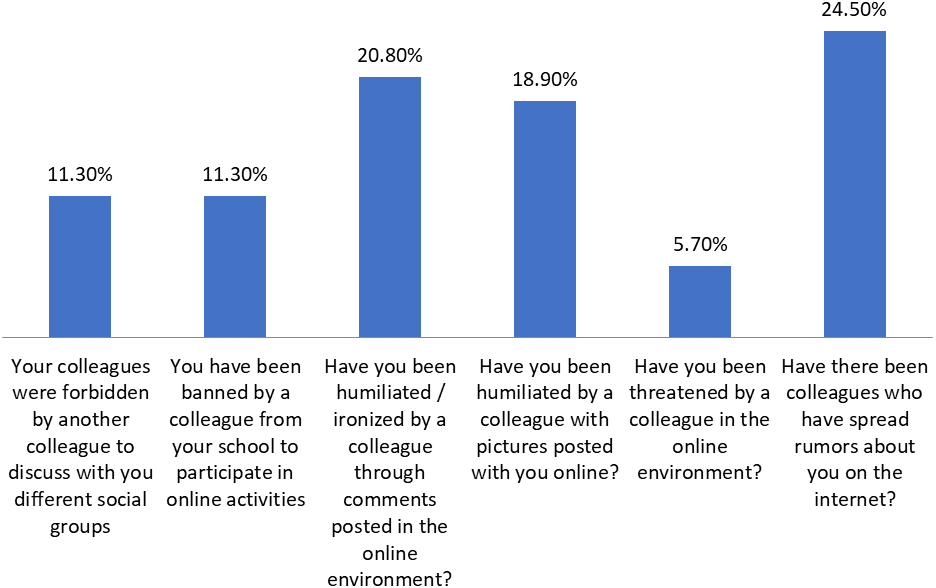
In Figure
The answers to question 17 recorded the reasons for cyberbullying and the results are in Figure

Mistakes and misunderstandings are reported by 69,8% out the total participants as being a cause for cyberbullying, while the desire for superiority and a source for strength was identified by 49,1% of the respondents.
Findings
Analysing the results obtain by the current research there are a lot of data that help answer the research questions. The present study concentrated on gymnasium students and wanted to find cases and number of cases for bullying and cyberbullying. The questions from the questionnaire were designed to give light into these complex phenomena prevalent in todays live of students of different ages. Among the most common means of bullying there are verbal aggressiveness, repetitive irony and teasing. Behaviours were also analysed based on the answers given by the students. When taking into consideration the male population: pushing, hitting and fighting are the most common acts of bullying that they identified as being a victim. Female participants reported pushing, hitting and pinching as more common among bullying acts. Students were also asked to view themselves as aggressors and give their answers regarding acts of bullying that they inflicted on others. Males reported that pushing and pinching was a common practice, while fighting was less of a mean of action. Females expressed that pushing and pinching was prevalent, followed by acts of hitting and fighting was less of a common act. As witnesses female respondents encountered more acts of aggression: fighting among colleagues, destroying things, rumour spread and humiliations were more common among their peers.
Reporting on the cyberbullying actions the students were also asked for their time and means of access of the internet. Almost all the participants have constant access to the internet and access it daily. They mostly use it for social media – to socialize, movies or online gaming were among the favourite activities of the respondents. Concerning the acts of cyberbullying encountered, students reported that posting annoying comments was the most common, followed by banning from online chats or messenger groups, even false profiles on social media was a mong the most frequent act of cyberbullying. Spreading rumours and online humiliations was reported by the majority of the students. Students also identifies some of the factors that contribute to cyberbullying: misunderstanding, mistakes, unresolved issues, the desire to show strength are among the most common.
Conclusion
Therefore, the theoretical perspectives of bullying, cyberbullying, aggression and violence are not only valuable judgments, it is difficult to realize differences of nuances between the four concepts, but involves a whole process of measuring and analysing data. Certainly, defining bullying, cyberbullying in the educational context by these terms would mean narrowing the causality of the phenomenon. In the light of the current interest in the issue of bullying and cyberbullying, it is only the idea that none of the concepts presented is (are) altogether a synonym for them.
References
- Cairns, R. B., & Cairns, B. D. (1991) Social cognition and social networks: A developmental perspective. In Pepler, D. J., & Rubin, K. H. (Eds.), The Development and Treatment of Childhood Aggression. New York, NY: Psychology Press.
- Germain, C. B., & Bloom, M. (1999). Human Behavior in the Social Environment: An Ecological View. Columbia University Press.
- Mureşan, L., & Porkolab, A. (2017). The effect of bullying and cyberbullying in primary school students communities. Education, Religion, Family in the contemporary society. Lap Lambert. Academic Publishing.
- Olweus, D. (1999). Violences entre les élèves, harcèlement et brutalités: Les faits, les solutions. Paris: ESF éditeur.
- Sullivan, K. (2011). The anti-bullying handbook. Los Angeles, CA: SAGE.
Copyright information

This work is licensed under a Creative Commons Attribution-NonCommercial-NoDerivatives 4.0 International License.
About this article
Publication Date
17 June 2020
Article Doi
eBook ISBN
978-1-80296-084-6
Publisher
European Publisher
Volume
85
Print ISBN (optional)
-
Edition Number
1st Edition
Pages
1-814
Subjects
Teacher, teacher training, teaching skills, teaching techniques, special education, children with special needs
Cite this article as:
Mureșan, L. M. (2020). Bullying And Cyberbullying Proximal And Specific Differences In Middle Schools In Romania. In V. Chis (Ed.), Education, Reflection, Development – ERD 2019, vol 85. European Proceedings of Social and Behavioural Sciences (pp. 536-544). European Publisher. https://doi.org/10.15405/epsbs.2020.06.53
